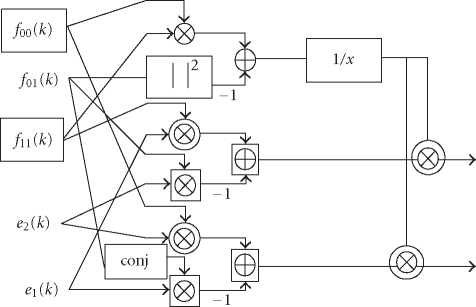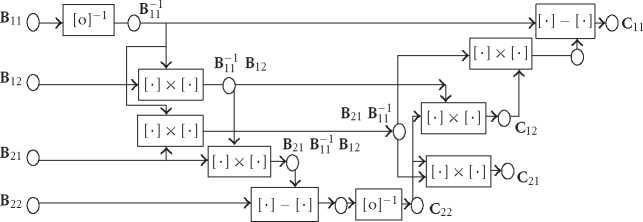EURASIP Journal on Applied Signal Processing

Figure 4: The merged 2 × 2 inverse and multiplication.

Figure 5: The data path of the partitioned 4 × 4 matrix inverse for each subcarrier.
It can be shown that the subblocks are given by the following
equations from the matrix inverse lemma [22]:
C22(i) = [B22(i) ^ B21(i)B11(i) 1B12(i)] ,
C12(i) = -B11(i)-1B12(i)C22(i),
C21(i) = -C22(i)B21(i)B11(i)-1,
C11(i) = B11(i)-1 - C12(i)B21(i)B11(i)-1.
(21)
Without looking into the data dependency, a straightfor-
ward computation will have 8 complex matrix multiplica-
tions, 2 complex matrix inverses, and 2 complex matrix sub-
tractions, all of the size (2 × 2). By examining the data de-
pendency, we will find some duplicate operations in the data
path. For a general case before considering the Hermitian
structure of the F[i] matrix, a sequential computation has the
data-dependency path given by Figure 5. The raw complex-
ity is given by 6 matrix mult, 2 inverses, and 2 substractions.
From the data path flow, the critical path can be identified.
Now we utilize the Hermitian feature of the F matrix
to derive more parallel computing architecture. Because the
inverse of a Hermitian matrix is Hermitian, that is, F-1 =
[F-1]H, it can be shown that
B-11(i) = [B-1(i)]H =⇒ C11(i) = [C11(i)]H,
B12(i) = [B21(i)]H =⇒ C12(i) = [C21(i)]H, (22)
B22(i) = [B22(i)]H =⇒ C22(i) = [C22(i)]H.
This leads to the data path by removing the duplicate compu-
tation blocks that has the Hermitian relationship. However,
this straightforward treatment still does not lead to the most
efficient computing architecture. The data path is still con-
structed with a very long dependency path. To fully extract
the commonality and regulate the design blocks in VLSI, we
define the following special operators on the (2 × 2) matrices
for the different complex operations. These special operators
are mapped to VLSI processing units to deal with the special
Hermitian matrix.
Definition 1 (pseudo-power). pPow(a, b) = %(a) ■ %(b) +
3 ( a) ■ 3 ( b) is defined as the pseudo-power function of two
complex numbers and %(a, b) = %(a) ■ %( b) - 3 ( a) ■ 3 ( b)
is defined as the real part ofa complex multiplication.
Definition 2 (complex-hermitian-mult). For a general (2 ×2)
matrix A and a Hermitian (2 × 2) matrix B = BH, we define
the operator CHM (Complex-Hermitian-mult) as
M(A, B) = AB = (a11 a 12Wb11 b21 ʌ . (23)
a21 a22 b21 b22
Note that all the numbers are complex except {b11, b22} ∈ R.
Definition 3 (Hermitian inverse). For a (2 × 2) Hermitian
matrix B = BH, the Hermitian inverse (HInv) operator is
More intriguing information
1. The English Examining Boards: Their route from independence to government outsourcing agencies2. The name is absent
3. The name is absent
4. The name is absent
5. PROFITABILITY OF ALFALFA HAY STORAGE USING PROBABILITIES: AN EXTENSION APPROACH
6. Eigentumsrechtliche Dezentralisierung und institutioneller Wettbewerb
7. The name is absent
8. The name is absent
9. From Aurora Borealis to Carpathians. Searching the Road to Regional and Rural Development
10. An alternative way to model merit good arguments